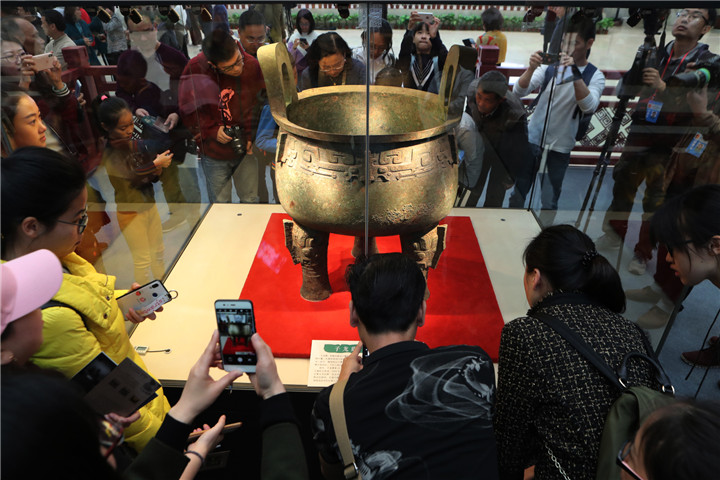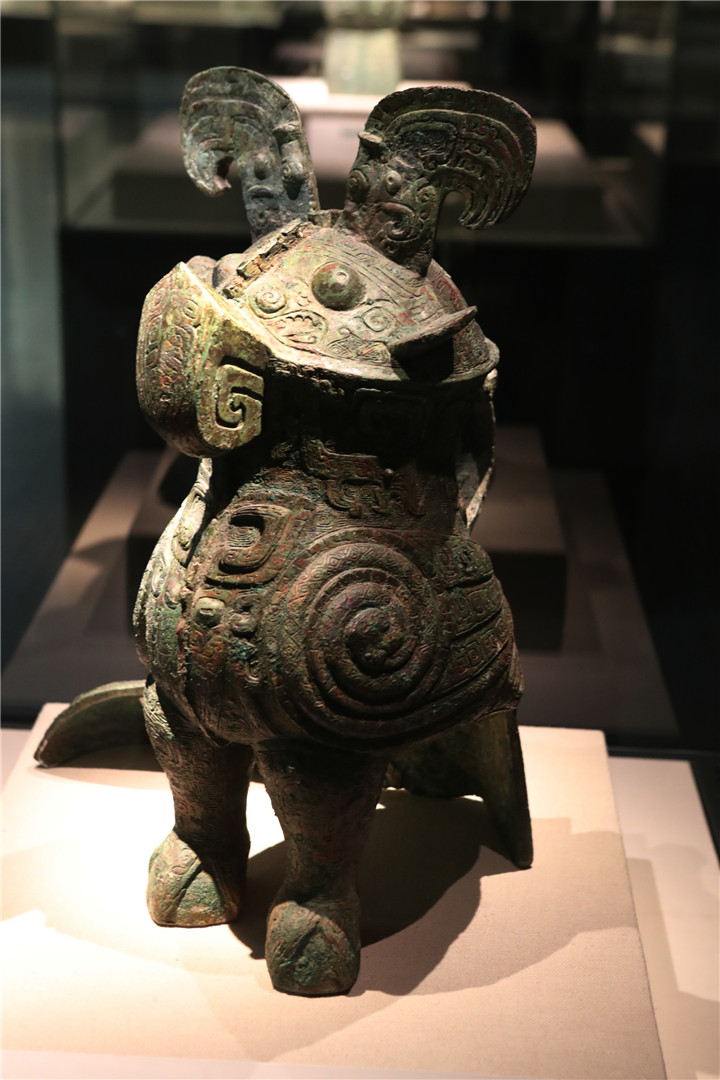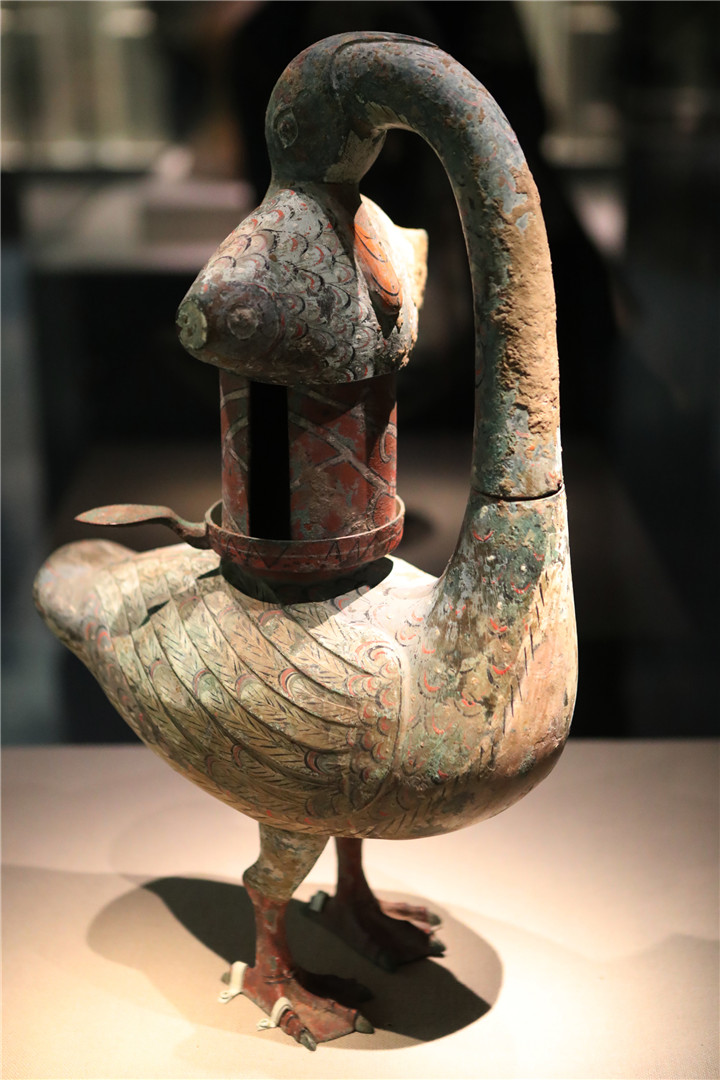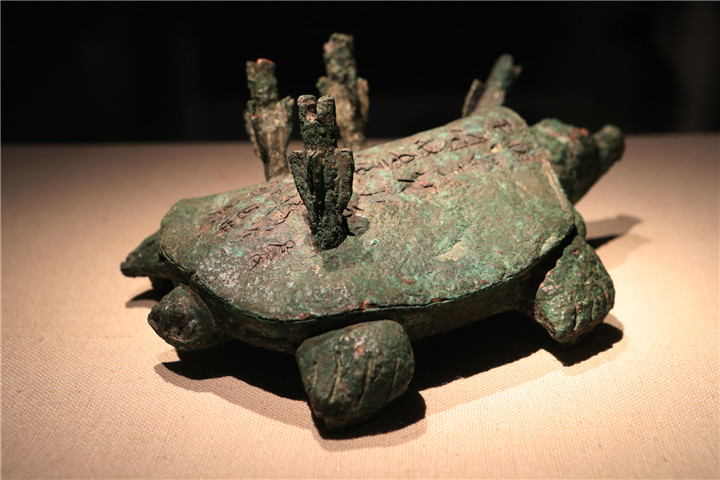National bronze treasures hit town
Writer: Cao Zhen | Editor: Doria Nan | From: Shenzhen Daily | Updated: 2019-01-22
The National Museum of China in Beijing, one of the largest museums in the world, has brought 148 bronze pieces, including several masterpieces, to Shenzhen Museum at a newly opened exhibition. Entry is free.
Recommended masterpieces for visitors include the Zilong Cauldron (子龙鼎), the Dragon and Tiger Vessel (龙虎纹尊), the Fu Hao Owl-shaped Vessel (妇好鸮尊) and the Painted Goose and Fish Lamp (彩绘雁鱼釭灯).

The Zilong Cauldron represnts the high level of late Shang bronze technology and art. Photos by Sun Yuchen
The Zilong Cauldron (1300-1046 B.C.), the largest Shang-Dynasty (1600-1046 B.C.) round ding (鼎) discovered to date, is the most significant object of the exhibition. So it is exhibited in the lobby in Shenzhen Museum, while other items are shown in an exhibition room on the first floor.
Said to have been excavated in the 1920s from Henan Province, the Zilong Cauldron is an imposing piece. Elegant yet powerful with well-ordered animal designs and text, it reflects the high level of late Shang bronze technology and art.

Fu Hao Owl-shaped Vessel.
The Fu Hao Owl-shaped Vessel (1300-1046 B.C.), excavated in 1976 from the tomb of Fu Hao in Henan Province, is a cute animal-shaped treasure. This bronze wine vessel bearing the design of an owl has rich and delicate patterns. Although from a modern aesthetic point of view this symmetrical owl vessel is endearing, in the Shang Dynasty, the owl was believed to hold mythical power. So many Shang bronzes were clearly inspired by the owl motif, either in form or in exterior. This particular Fu Hao Owl-shaped Vessel is solemn and powerful, and its two legs and tail form a triangle that supports the vessel.

Painted Goose and Fish Lamp.
The Painted Goose and Fish Lamp (206 B.C.-8 A.D.), excavated in 1985 from Shanxi Province, is a beautiful and vivid lamp in the form of a goose with its head turned back and holding a fish in its mouth. The crest is painted red, the goose and fish body in green, with the wings and the scales outlined in ink. According to the National Museum of China’s website, lamps made in the Han Dynasty (202 B.C.-220 A.D.) are diverse in form, such as wild goose foot, a recumbent sheep, the mythical Vermillion Bird and an ox. With its lively form, ingenious design and gorgeous decoration, this goose and fish lamp perfectly combines function and form.
The Dragon and Tiger Vessel (1300-1046 B.C.), excavated in 1957 in Anhui Province, is also a large wine zun (尊), designed with protruding wriggling dragons and a tiger relief. The mixture of engraving, relief and delicate designs make it a masterpiece.

Zuoceban’s Turtle
Other must-see items include the Zuoceban’s Turtle (作册般鼋), the Eagle-head Pot With Handle (鹰首提梁壶) and the Animal Face Ax (兽面纹铜钺). According to the engraved text on the Zuoceban’s Turtle, one day, the Shang emperor came to the banks of a river and found a turtle. He shot four arrows into it, and not one missed. The emperor gave it to an official and commanded him to make a bronze ware to honor this event.
Bronze art has a long and lustrous history in China, lasting 4,000 years from the Xia Dynasty (2070-1600 B.C.) to today. The National Museum of China not only has a very large bronze collection but also includes all types of items, including vessels, weapons, musical instruments, implements, agricultural tools, horse and chariot fittings and all sorts of everyday objects. As a manifestation of the politics, economics, culture and life of their time, this is an important repository for the study of history, art and technology, and a precious cultural heritage for the development of human civilization.
To help visitors quickly grasp bronze art, the Shenzhen exhibition has divided the exhibits into five parts, instructing visitors to admire bronze ware from the perspectives of shape, design, engraved text, casting crafts and corrosion.
Dates: Until March 31
Hours: 10 a.m.-6 p.m., closed Mondays
Venue: Shenzhen Museum, Civic Center, Futian District (福田区市民中心深圳博物馆)
Metro: Line 2 or 4 to Civic Center Station (市民中心站), Exit B